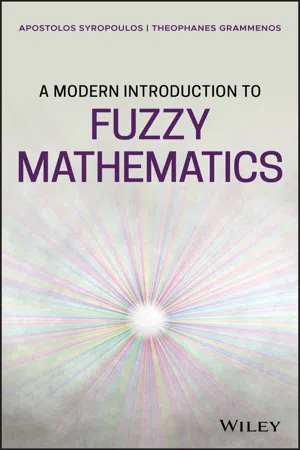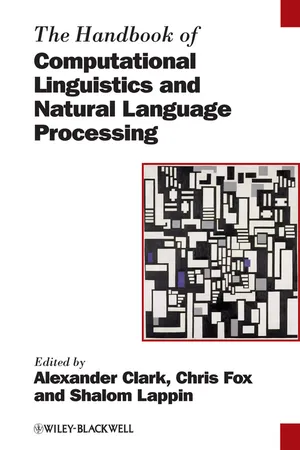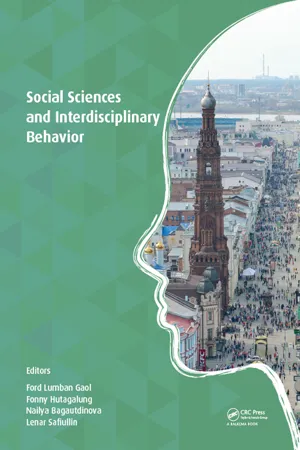Finite Automata
Finite Automata are abstract machines used to model and analyze the behavior of systems with a finite number of states. They are widely used in computer science for tasks such as lexical analysis, pattern matching, and parsing. Finite Automata operate by transitioning between states based on input symbols, making them valuable tools for understanding and solving computational problems.
3 Key excerpts on "Finite Automata"
- eBook - ePub
- Apostolos Syropoulos, Theophanes Grammenos(Authors)
- 2020(Publication Date)
- Wiley(Publisher)
...If the machine enters the final state, then it accepts the input and terminates. The machine may suspend without completion when no transition rule applies. The alphabet of the machine consists of the symbols that the scanning head can recognize. The following figure shows a finite automaton with two states whose alphabet is. The symbols in the circles are the states, the symbol in the double circle is the accepting state, and the symbols over the arcs are the symbols that the automaton consumes. Thus, this is a compact way to write the various transition rules. This automaton determines if an input sequence of symbols over its alphabet contains an even number of 's. For example, if the input is the sequence “”, then the following table shows what has to be done in order to have this sequence accepted by this automaton. Current state Unread symbols Transition rule Input accepted! More generally, automata are able to examine whether character sequences or just strings belong to some formal language. Definition 8.1.1 Assume that is an arbitrary set of symbols, which is called alphabet, and that denotes the empty string. Then, is the set of all finite strings over. A formal language, or just language, is a subset of, that is,. Typically, a language is defined by a grammar: Definition 8.1.2 A grammar is defined to be a quadruple where and are disjoint sets of terminal and nonterminal (syntactic class) symbols, respectively;, a distinguished element of, is called the starting symbol. is a finite nonempty relation from to...
- Alexander Clark, Chris Fox, Shalom Lappin, Alexander Clark, Chris Fox, Shalom Lappin(Authors)
- 2013(Publication Date)
- Wiley-Blackwell(Publisher)
...In contrast, finite state automata offer a way of dealing with the central phenomena of morphology without recourse to such a step-by-step derivation: hence the term ‘two-level morphology,’ which employs only two levels: one in which morphosyntactic features and lexical roots are specified, and one which matches the spelled (or pronounced) form of the word. We return to this in Section 4.2.The notion offinite state automaton(often abbreviated asFSA)was first presented in Kleene (1956), itself inspired by the work of McCulloch and Pitts (1943) some ten years earlier. An FSA is a kind of directed graph: a directed graph is by definition a finite set of nodesM,along with a set of edges E, where an edge is an ordered pair of nodes.Nodesin an FSA are often calledstates.For a directed graph to be an FSA, it must be endowed with three additional properties: it must have a distinguished node identified as itsstartstate; it must have a set of one or morestopping(oraccepting)states; and it must have a set of labels,with each edge associated with exactly one label in. Whilecannot in general be null, it may contain the null string as one of its members. In purely mathematical contexts, it is convenient to assume that each label is an atomic element, indivisible, but in the context of computational linguistics, we rather think ofas a subset ofΣ∗,for some appropriately chosenΣ. In that way, the morphs of a given language (e.g.,jump, dog, ing)will be members of, as will be descriptions of grammatical feature specifications, such as first person or past tense.When we explore an FSA, we are typically interested in the set of paths through the graph, and the strings associated with each such path - we say that a pathgeneratesthe string...
- eBook - ePub
Social Sciences and Interdisciplinary Behavior
The 4th International Congress on Interdisciplinary Behavior and Social Science (ICIBSoS 2015), Kazan Federal University, Kazan, Russia, 22-23 October 2015 & Arya Duta hotel, Jakarta, Indonesia, 07–08 November 2015
- Ford Lumban Gaol, Fonny Hutagalung, Nailya Bagautdinova, Lenar Safiullin, Ford Lumban Gaol, Fonny Hutagalung, Nailya Bagautdinova, Lenar Safiullin(Authors)
- 2016(Publication Date)
- CRC Press(Publisher)
...This is reached by the approach when the creature’s models act like actors in the theater and show different episodes of real life (conversation on the benchmark with an old friend, greeting of a familiar guy, working in the garden, etc.). For the realization of this “theater”, programmers need to create artificial intelligence, which manages the behavior of the characters and animals such as the director or screenwriter. We tried to represent creatures’ AI with BDI model [ 1 ], but our descriptions required RTL [ 2 ] or temporal logic [ 3 ] and they became very large, so we decided to use simple finite state machines to describe AI. Conception of the finite state machine is useful for this realization. Furthermore, this conception is very efficient, because a lot of similar game projects have used it (including outstanding games such as Assassin’s Creed, Grand Theft Auto, Dishonored, and so on). We describe a Domain-Specific Language (DSL) to define FSM, which uses an automata-based approach [ 4 ]. This approach allows us to decompose our models. We were inspired by the usage of finite state machines in the hybrid system simulation [ 5 ] and by the languages introduced to simulate the complex behavior. In the game development, FSM were used in several games, however, authors have not found the languages that can be used to define FSM and the use and reuse of this definition from different programming languages. 2 DEFINITIONS Let us recall the basic definitions and introduce several notions that we will use in the next sections. Definition 1 (DFA) Deterministic Finite Automaton is tuple (S, X, Y, δ, s 0), where S is a finite set of states, X and Y are finite alphabets of input and output correspondingly, δ: S × X → S × Y* is transition function and s 0 ∈ S. DFA works as follows. Initially, it is in state s 0. Then DFA receives some input character...


